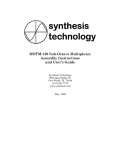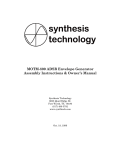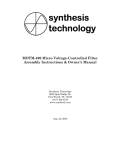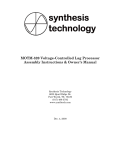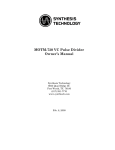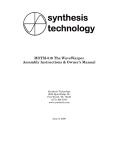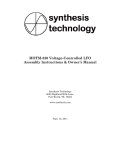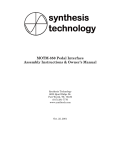Download MOTM-650 User`s Manual
Transcript
MOTM-650 4CH MIDI-CV Converter User’s Guide Synthesis Technology 6625 Quail Ridge Dr. Fort Worth, TX 76180 (817) 281-7776 www.synthtech.com April 5, 2006 GENERAL INFORMATION Thank you for purchasing the MOTM-650 4CH MIDI-CV Converter. If you have any issues concerning the use of the MOTM-650, please contact us at (81) 281-7776 or by email: [email protected] TROUBLESHOOTING GUIDE If your MOTM-650 does not work as expected, keep in mind the MOTM-650 is a somewhat complex device, and more often than not, problems encountered are related to a feature set to an unexpected value. If the MIDI LED does not light up when you are sending MIDI data, then the MIDI channel(s) is not properly set. This should be the first thing to check. The MOTM-650 has 2 internal trim pots: LCD contrast and a master (for all 4 channels) 1V/Oct setting. Both of these use a very small flat-bladed screwdriver. Eyeglass or jeweler’s screwdrivers are needed. However, these are factory set and should never need adjustment. Instead, you may need to retrim the 1V/Oct trimmers on your VCOs and VCFs if you are experiencing tracking problems. SYNTHESIS TECHNOLOGY MOTM-650 USER’S GUIDE WWW.SYNTHTECH.COM PAGE 2 FRONT PANEL The MOTM-650’s front panel looks like this: SYNTHESIS TECHNOLOGY MOTM-650 USER’S GUIDE WWW.SYNTHTECH.COM PAGE 3 From top to bottom: LCD – This 8 character by 2 line LCD is the primary user interface for settings, status, and other MOTM-650 related information. The LCD backlight can be controlled via global settings. MIDI – Indicates MIDI activity on input to the MOTM-650. This is an indicator of all MIDI data sent to the MOTM-650’s MIDI IN – not just MIDI data bound for the MOTM-650. Note that this LED is lit by the MOTM-650’s processor, not directly from MIDI data pin. Voice 1-4 LEDs – These LEDs indicate when a voice Gate signal is either high (lit) or off (not lit). If a voice is set as an S Trigger, an LED on indicates the Gate is inactive and off indicates the Gate is active. Beat LED – This LED will blink at the rate of the clock source. ESCAPE – The ESCAPE button is used to either cancel a setting change, or move to a higher level function. Just remember, when in doubt, press ESCAPE. ENTER – The ENTER button is used to accept a setting change, step to a lower level function, or confirm that a changed setting is desired. -/+ - The -/+ buttons either increment or decrement a menu options or a setting. In some contexts, holding down either button will cause an accelerated repeat of either button, which makes changes happen more quickly (think of it as being like a key repeat on any computer keyboard). MIDI IN – The MOTM-650’s MIDI input. MIDI OUT – The MOTM-650’s MIDI output. EXT Clock – Standard clock pulse input for external clocking of the MOTM-650. The clock threshold is set at +1.25V. You can drive this directly from an LFO (MOTM-320/380/390) or a VCO (MOTM-300/310). Use a square or pulse waveform if possible. Triangle is better than sine or saw. Note: the maximum input frequency of External Clock is 280Hz. Exceeding this input frequency may cause erratic operation. Aux 1-4 – 10 Bit accurate assignable auxiliary outputs – one for each voice. See the voice group section of this manual for information on their operation. The output voltage can be selected to be 0-1V, 0-2V, 0-4V or 0-8V full-scale. Vel/Trig 1-4 – 10 Bit velocity output or trigger. This jack’s function is dependent on the voice group setting. The output voltage can be selected to be 0-1V, 0-2V, 0-4V or 0-8V fullscale. Gate 1-4 – Gates for each of the individual voices. These directly track the Voice 1-4 LEDs as described above. When high, the output is +12V. When low, it is less than 0.1V. SYNTHESIS TECHNOLOGY MOTM-650 USER’S GUIDE WWW.SYNTHTECH.COM PAGE 4 CV 1-4 – 16 Bit accurate, low-drift control voltage outputs, usually connected directly to VCOs. One CV per voice. These are set for –2V to +8V full-scale range and cannot be reprogrammed. USER INTERFACE INTRODUCTION Before getting in to the specifics of the MOTM-650’s feature set, let’s get comfortable using the MOTM-650’s user interface. Switch on the MOTM-650. The LCD will light up and indicate the MOTM-650 and its firmware version number, followed by a screen looking something like this: G1 CH=1 SOLO ROT For now, ignore its meaning – press ENTER. The MOTM-650 will display this: GLOBAL OPTIONS Press the -/+ buttons to scroll through the top level user functions. Notice that eventually the options will loop back around to GLOBAL OPTIONS. At this point, a top level function is being selected. Notice that + moves forward and – moves backward through the list of top level functions. With + or -, select GLOBAL OPTIONS and press ENTER. The LCD will show: VGRPTYPE 4 Get comfortable scrolling through the global options by using + or -, and when finished, press ESCAPE. This backs the display back out to the top level menu, and will show: GLOBAL OPTIONS This is how the entire menu system is structured – to have a top level of functions, followed by a single level of multiple suboptions. And pressing escape at any time will back up one level. Okay, now that the basic understanding of top level/sublevel menus are understood, get the screen back to GLOBAL OPTIONS again, and press ENTER until VGRPTYPE 4 is shown. For the time being, let’s ignore what this means, and use the + or – buttons until the display shows: CLOCK INTERNAL The display will be steady. Press ENTER – notice that INTERNAL begins to flash. This has indicated to the MOTM-650 that it’s going to be changed. Press + or – to scroll through SYNTHESIS TECHNOLOGY MOTM-650 USER’S GUIDE WWW.SYNTHTECH.COM PAGE 5 INTERNAL, EXTERNAL, or MIDI. Select MIDI, and press ENTER. The display should show: CLOCK MIDI And MIDI should be steady. This has changed the clock source from internal to MIDI clock. This is how a change is made – press ENTER to indicate the change, use -/+ to set the value, and press ENTER again to tell the MOTM-650 to make the change permanent. Let’s try one more aspect of the MOTM-650’s user interface – With the display showing CLOCK MIDI, press ENTER again. MIDI Will begin to flash. Use -/+ to select EXTERNAL on the display, but instead of pressing ENTER, press ESCAPE instead. The display will show: CLOCK MIDI This option allows the user to back out of a change before it becomes permanent, and the option will be set back to whatever it was before the change was made. In short, press ENTER to change an option, change the option with -/+, then either press ENTER to select the change or ESCAPE to cancel it. All settable options work this way! Keep in mind that the entire MOTM-650’s user interface works just as above, regardless of function or feature. Note that all MOTM-650 changes/functions are transmitted via MIDI. This is useful in case a live performance is being done and a recording of all front panel changes are desired. All functions are stored in internal flash. Once a setting change is made, it’s saved across power cycles. The MOTM-650’s entire active state is saved in nonvolatile memory. the MOTM-650’s functionality can be broken up into four categories of functions: GLOBAL – Global options apply to the MOTM-650 as a whole. Most global options apply to all voice groups simultaneously. These features include, but are not limited to, clock source, tuning tables, tempo, voice group configuration, etc… VOICE GROUP – A voice group is a logical grouping of voices. Each voice group has settings apply to all voices of that particular voice group. ARPEGGIATORS – There are two arpeggiators, each of which can be assigned to a voice group, no voice group, or both to the same voice group. Arpeggiators use settings from global options (such as clocking) and have their own settings available. MODULE ACTIONS – These functions are one shot actions that perform global functions, such as dumping patches, storing patches, etc… They are not settings as in global, voice group, or arpeggiator categories, rather just instructions to perform a specific action. SYNTHESIS TECHNOLOGY MOTM-650 USER’S GUIDE WWW.SYNTHTECH.COM PAGE 6 Note: Suboptions may appear and disappear in the menus depending upon how the MOTM650’s options are set. For example, setting the clock source to MIDI will cause the internal clock BPM setting to disappear from the global option menu. There are only a few cases where this occurs, and it’s done to ensure that only the options that will have an effect on the MOTM-650’s operation are visible at any given time. If one of the expected options doesn’t appear, check the MOTM-650 menu chart to see if another option controls whether or not it appears. MOTM-650 Operation This section describes the basic MOTM-650. If unfamiliar with the MOTM-650’s overall operation, this section should be thoroughly understood. Voice groups Before getting into the details of the MOTM-650’s features, let’s first start with a description of the most important aspect of understanding the MOTM-650 - voice groups. The MOTM-650 has three modes of operations for groups of voices. It is selected as a global option called VGRPTYPE: 4: 1 Group – 4 Voices per group (Group 1=Voices 1-4) 2/2: 2 Groups – 2 Voices per group (Group 1=Voices 1&2, Group 2=Voices 3&4) 1/1/1/1:4 Groups – 1 Voice per group (Group 1=Voice 1, Group 2=Voice 2, Group 3=Voice 3, Group 4=Voice 4) Each voice group has a set of options that apply to that entire voice group: MIDI Channel Voice allocation mode Glide/Portamento type Gate type Velocity/trigger selections Aux output assignment Aux output scaling Glide/Portamento time for constant rate/constant time Each one of the settings listed above applies only to the setting in that voice group. That means there can be different portamento settings for each voice group, different voice allocation modes, different MIDI channels, etc… or in the odd case, more than one group can have the same MIDI receive channel! They are completely independent from each other. For the sake of this example, let’s assume a single VCO and MIDI channel 1. Set the MOTM-650 to the following settings: • Go to the GLOBAL OPTIONS menu and change VGRPTYPE to 4 (single group, 4 voices per group). SYNTHESIS TECHNOLOGY MOTM-650 USER’S GUIDE WWW.SYNTHTECH.COM PAGE 7 • • • • Press ESCAPE to return to the top menu level, and select the VOXGRP1 submenu, and press ENTER. The first option shown is VG1 ALLC – set the option to SOLO for now. Remember, press Enter to cause the selection to blink, hit the ‘-‘ key until SOLO appears, then press ENTER. This will cause the MOTM-650 to allocate only the first voice in the group of 4. While still under the VOXGRP1 submenu, find the VG1 MIDI option and change the group’s MIDI channel to match the controlling keyboard. Wire a VCO’s output through a VCA with a gate input, and then to a monitoring setup (e.g. amplifier or headphones) – skip envelope triggering for now to simplify the example. Connect the GATE 1 jack to the VCA’s gate input Now press a key on the MIDI controller. Several things should happen: • • • The MIDI light will blink The Voice 1 LED will turn on The played note will be heard Try the pitch bend (set to 2 note -/+ bend range by default), a few more notes, etc… Everything should respond like a normal monophonic synthesizer. Now, change the VGRPTYPE to SOLO ROT. This will now cause the MOTM-650 to allocate voices across all voices within a group. Since the MOTM-650 is set to 4 voices, it will allocate out of a pool of all 4 voices. Even if voices 2 through 4 aren’t connected to anything, play some notes. Every note press will cause the next voice to be allocated. With one VCO connected, only 1 voice will be heard out of every 3 notes. The user’s guide will go in to detail of all of the voice modes and how they work, but for now, focus on the operation of the voice groups. The MOTM-650 is currently set up for a single voice group. Go into the GLOBAL OPTIONS menu and change the VGRPTYPE to 2/2 (two groups, 2 voices per group). Escape out to the top level menu, and notice that VOXGRP2 is now a new menu option! As with VOXGRP1, change the VG1 ALLC to SOLO ROT (solo rotate) just like with voice group 1. Also set the MIDI channel to a different MIDI channel (preferably one higher than it’s currently set). Now press notes on the controller keyboard. Notice now that only voices 1 and 2 are active – this is sending MIDI data to voice group 1. Change the keyboard controller to the same MIDI channel as voice group 2, and play. Voices are allocated out of voices 3 and 4. The voice grouping operation allows completely different behaviors, turning the MOTM-650 into a dual 2 voice MIDI/CV converter, or a quad single voice MIDI/CV converter. Very powerful and flexible! The MOTM-650 has one very unique function – voice groups can be assigned to the same MIDI channel. Change VOXGRP1’s MIDI channel to the same as VOXGRP2’s MIDI channel. Play notes. Watch voice 1 & 3 turn on simultaneously, and 2 & 4 turn on simultaneously. SYNTHESIS TECHNOLOGY MOTM-650 USER’S GUIDE WWW.SYNTHTECH.COM PAGE 8 Having both voice groups set to the same MIDI channel is identical to sending notes/controllers on two different MIDI channels – the single incoming note is being sent to both voice group’s allocation. One possible use for this is to have multiple VCOs on a single voice. Connect one VCO to voice 1, and another to voice 3. Detune the second VCO to an octave below (or above), etc… it’s a great way to get unique voices if a CV splitter isn’t available. Also consider that each voice group can have different glide settings. Configuration of a modular system with this voice group setup is only limited by the user’s imagination. Now that the voice group concept has been covered sufficiently, let’s explore all of the options available for each voice group: MIDI Channel This option sets the voice group’s MIDI channel. The voice group will respond to MIDI CCs, pitch bend, notes, and all other voice group functions on this channel. Note that MIDI channels are not exclusive – more than one voice group can be set to the same MIDI channel. Voice allocation modes The MOTM-650 has 9 voice allocation modes that are assignable on a per group basis. Each voice allocation mode has a specific use, and is described below. For the sake of their understanding, it’s recommended that the MOTM-650 is set to a single 4 voice group mode and special attention is paid to the voice gate LEDs to visually understand their operation: Poly 1 POLY 1 Mode is a polyphonic mode, and is designed to preserve a note's RELEASE as long as possible. Here is an example of how it works: If A B C D E F are played in WHOLE mode, releasing the keys in reverse order (F E D C B A) will cause the next allocated voice to be F. That is because it has been released the longest, so it has the best chance of having completed the RELEASE cycle of its envelopes. As with UNISON mode, when too many notes are played, the later notes will not sound, at least until one or more of the other notes playing are released. Poly 1 steal It works like the POLY 1 mode until there are no free allocated voices. Then, like UNISON STEAL, it will steal the earliest note's voice to play the new note. If voice watch is enabled, the stolen voice will be indicated by a LED wink on that voice. Poly 2 POLY 2 Is, as the name implies, polyphonic, and is designed for use with PORTAMENTO. If a chord is played, then release the notes and play a new chord. The notes of the new chord will be reassigned to the same voices. Normally this just means that the RELEASE of SYNTHESIS TECHNOLOGY MOTM-650 USER’S GUIDE WWW.SYNTHTECH.COM PAGE 9 the notes gets cut off, but if PORTAMENTO is on, a super cool polyphonic glide sound will be heard that will make you the envy of your friends! POLY 2, Like POLY 1 and UNISON, does nothing when more notes are played than allocatable. Poly 2 steal POLY2 STEAL works like POLY 2 until there are no more allocatable voices, at which point it acts like the other steal modes. Unison UNISON Is a polyphonic mode, meaning more than one note can be played at a time. The idea behind UNISON is to make the fattest sound possible. The UNISON mode works like SOLO UNISON for the first note played, then things start getting strange. If two or more notes are being played, the voices divide between the notes played. Since the number of different voices available depends on if the board is in WHOLE or SPLIT mode, the number of voices per note depends on the KEY MODE as well. It is confusing, so here is a table to make it easier to understand: Nice table needs to go here ☺ Unison steal It is just like UNISON mode, until more notes than there are available voices are played. Then, the oldest note playing has its voice stolen to play the new note. For instance, in WHOLE mode, when the seventh note is played, it plays, but the first note goes silent. The second note goes silent to play the eighth note, and so on. Each new note retriggers the envelope with a new ATTACK. Now, if a note is released while the first and second notes are still held, the second note will sound. Release another key and the first note will sound. The notes that have their voice stolen and get replayed will not retrigger the envelopes. The STEAL modes are great for playing chords. If voice watch is enabled, a winking LED will indicate the stolen voice(s). Solo SOLO Mode will only sound one note at a time - the last note played. If a note is held down and another note played, the voice will jump to the new note, but the envelope will not retrigger. This allows playing of smooth solo lines. If the second note is released before the first note, the first note will sound again. If the sound quickly dies away, try increasing the SUSTAIN level of ENV-2. A patch with a quick ATTACK and DECAY with no SUSTAIN does not work well in SOLO mode because the envelope only gets retriggered when all notes are released. Only one voice is used in SOLO mode. SYNTHESIS TECHNOLOGY MOTM-650 USER’S GUIDE WWW.SYNTHTECH.COM PAGE 10 Solo Rotate As with SOLO mode, SOLO ROTATE sounds only the last note played. However, each new note is assigned to a new voice, which makes the envelope retrigger for each new note. This is good for playing short, percussive sounds with a long RELEASE, because new notes will not immediately interrupt the RELEASE with a new ATTACK like in SOLO mode (unless many notes are played quickly). All available voices are used in SOLO ROTATE mode. Solo Unison The SOLO UNISON mode works just like SOLO mode, only all available voices are used to play each note. If the board is in WHOLE mode, six voices sound at one time, and in SPLIT mode either four or two. This makes for some very fat sounds. The fatness can be adjusted by using the UNISON DETUNE knob just to the left of the ASSIGN buttons. A setting of 0 tunes the voices very close together, while a setting of 10 detunes the voices so much that it starts sounding nasty - but not a good sort of nasty. Glide/Portamento type The MOTM-650 has two modes of Glide/Portamento (referred to as Portamento from this point forward). The time settings apply to all voices within a particular voice group, but each individual voice within a voice group will slide independently to the target note assigned to that voice. For example, in a VOXGRP/4, it’s possible for voice 1 to be sliding from middle C to high C, while voice 2 is sliding from middle C to C below low C, and voices 3 and 4 are not sliding at all. CV Voltages continue to slide even after notes are released – portamento works independently of the gates. Slides always occur between the CV voltages of the source and target notes. This means that it’s based on CV value, not on MIDI note. Portamento will slide between the CV values for any tuning table. On powerup, all CVs are set to 0 volts, and will glide from that point to the first note pressed. Constant rate Constant rate portamento allows, on a per group basis, a consistent rate of slide. This means that slides of notes that are closer together are shorter than those farther apart. Constant rate follows an exponential curve from 60.562 cents/second to 16898.837 cents/second with 127 Constant time Constant time portamento will maintain the same time between two notes regardless of their distance. This is an adjustable value, from 1 millisecond to 65.535 seconds! Gate type SYNTHESIS TECHNOLOGY MOTM-650 USER’S GUIDE WWW.SYNTHTECH.COM PAGE 11 Each voice group can be assigned, as a whole, to provide either a standard positive trigger or S-trigger type of gate. It applies to all voices within a particular group, making it possible to gate each group separately, so that standard positive going and S-Triggers can be mixed. The voice lights on the MOTM-650s front panel track the current output of the gates, not the logical voice “state”. That is, setting S-trigger for a particular voice group will cause all of the voice LEDs for that group to turn on. This is the “off” position for S-trigger voices. For normal gates, a voice that’s turned off will cause the LED to be on, and a voice that’s on will light the LED. Normal With a normal gate type, an “off” gate will produce 0 volts, and an “on” gate 8 volts. S-Trigger S-trigger gates will produce 8 volts on the gate output when a voice is off, and 0 volts when it is on. This is useful for Moog style triggers. Velocity/trigger selections Aux output assignment Aux output scaling Glide/Portamento time for constant rate/constant time SYNTHESIS TECHNOLOGY MOTM-650 USER’S GUIDE WWW.SYNTHTECH.COM PAGE 12 SPECIFICATIONS MOTM-650 4CH MIDI-CV converter FEATURES GENERAL Power Supply 5VDC @ 300ma maximum -15VDC @ 20 ma maximum +15VDC @ 35 ma maximum Size 2U x 5U 3.485” x 8.735” 88.5mm x 221.9mm Depth behind panel 4 inches 101.6mm CONTROLS SYNTHESIS TECHNOLOGY MOTM-650 USER’S GUIDE WWW.SYNTHTECH.COM PAGE 13














